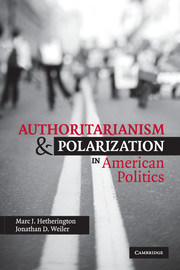Book contents
- Frontmatter
- Contents
- Acknowledgments
- 1 Spanking or Time Out: A Clash of Worldviews?
- 2 Putting Polarization in Perspective
- 3 Authoritarianism and Nonauthoritarianism: Concepts and Measures
- 4 A Historical Account of the Roots of Worldview Evolution
- 5 Authoritarianism's Structuring of Contemporary Issues
- 6 Threat and Authoritarianism: Polarization or Convergence
- 7 Evidence of Worldview Evolution
- 8 Immigration: A Reinforcing Cleavage that Now Constrains the Republican Party (GOP)
- 9 What the 2008 Democratic Nomination Struggle Reveals about Party Polarization
- 10 A New View of Polarization
- Epilogue
- Bibliography
- Index
6 - Threat and Authoritarianism: Polarization or Convergence
Published online by Cambridge University Press: 05 June 2012
- Frontmatter
- Contents
- Acknowledgments
- 1 Spanking or Time Out: A Clash of Worldviews?
- 2 Putting Polarization in Perspective
- 3 Authoritarianism and Nonauthoritarianism: Concepts and Measures
- 4 A Historical Account of the Roots of Worldview Evolution
- 5 Authoritarianism's Structuring of Contemporary Issues
- 6 Threat and Authoritarianism: Polarization or Convergence
- 7 Evidence of Worldview Evolution
- 8 Immigration: A Reinforcing Cleavage that Now Constrains the Republican Party (GOP)
- 9 What the 2008 Democratic Nomination Struggle Reveals about Party Polarization
- 10 A New View of Polarization
- Epilogue
- Bibliography
- Index
Summary
As the literature has evolved from treating authoritarianism as a static personality characteristic à la Adorno et al. (1950) to seeing it as a disposition that manifests itself in situation-specific circumstances (e.g., Feldman 2003; Stenner 2005), threat has come to play a starring role in understanding its effect. Scholars today tend to believe that the level of authoritarianism in a population generally stays the same over time (but see, e.g., Altemeyer 1996, who measures authoritarianism differently). Its effect, however, changes depending upon measurable circumstances. Specifically, most scholars argue that an authoritarian disposition lies dormant in the absence of threat, meaning that under this condition the preferences of the more and less authoritarian will not differ by much. Threat activates an authoritarian disposition, which, in turn, causes it to have measurable effects on opinions, behaviors, and preferences (see, e.g., Feldman and Stenner 1997; Stenner 2005, for the most complete treatment).
Although we wholeheartedly embrace the notion of situationism – that authoritarianism's effect will wax and wane depending on how threatened people feel – we will demonstrate that scholars have misunderstood the relationship between threat and authoritarianism. Worse, this flawed thinking encourages a fundamental misreading of the recent dynamics of American politics. In correcting this misunderstanding, we can better explain why support for gay rights, limitations on civil liberties, the use of force, and even approval of the president have tended to move in the directions they have over the last decade.
- Type
- Chapter
- Information
- Authoritarianism and Polarization in American Politics , pp. 109 - 133Publisher: Cambridge University PressPrint publication year: 2009
- 2
- Cited by



